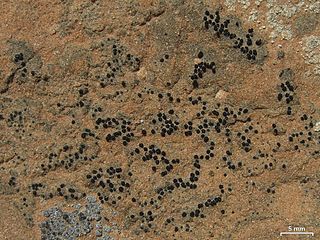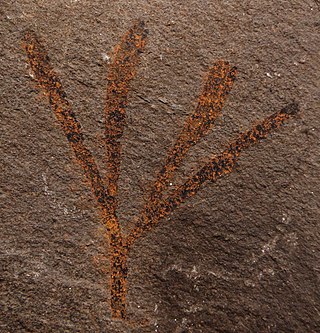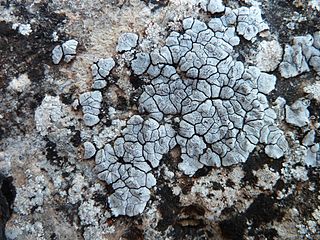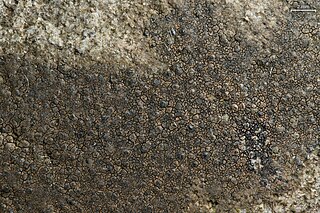
Calymene Brongniart, 1822, is a genus of trilobites in the order Phacopida, suborder Calymenina, that are found throughout North America, North Africa, and Europe in primarily Silurian outcrops. Calymene is closely related to Flexicalymene, and both genera are frequently found enrolled. Calymene trilobites are small, typically 2 cm in length. The cephalon is the widest part of the animal and the thorax usually has 13 segments.

Verrucariaceae is a family of lichens and a few non-lichenised fungi in the order Verrucariales. The lichens have a wide variety of thallus forms, from crustose (crust-like) to foliose (bushy) and squamulose (scaly). Most of them grow on land, some in freshwater and a few in the sea. Many are free-living but there are some species that are parasites on other lichens, while one marine species always lives together with a leafy green alga.
Clauzadella is a genus of fungi in the family Verrucariaceae. A monotypic genus, it contains the single species Clauzadella gordensis, discovered in France and described as new to science in 1996 by Pere Navarro-Rosinés and Claude Roux.
Bellemerella is a genus of fungi in the family Verrucariaceae. All four species are lichenicolous, meaning they grow parasitically on other lichens.

Placidiopsis is a genus of lichens in the family Verrucariaceae. The genus was circumscribed by Italian naturalist Francesco Beltramini de Casati in 1858, with Placidiopsis grappae assigned as the type species.
Involucropyrenium is a genus of lichens in the family Verrucariaceae. It has nine species. The genus was circumscribed by Austrian lichenologist Othmar Breuss in 1996, with Involucropyrenium waltheri assigned as the type species.

Heteroplacidium is a genus of lichen-forming fungi in the family Verrucariaceae. The genus was circumscribed by Austrian lichenologist Othmar Breuss in 1996 with Heteroplacidium imbricatum assigned as the type species. It was proposed as a segregate of Catapyrenium. Other morphologically similar genera are Neocatapyrenium, Placidium, and Scleropyrenium, although molecular phylogenetic analyses indicate that they are independent monophyletic lineages within the Verrucariaceae.
Henrica is a genus of crustose lichens in the family Verrucariaceae. It has four species. The genus was circumscribed by Maurice Bouly de Lesdain in 1921, with Henrica ramulosa assigned as the type species. The generic name Henrica honours Italian clergyman and lichenologist Joseph-Marie Henry (1870–1947).

Verrucaria is a genus of lichenized (lichen-forming) fungi in the family Verrucariaceae.

Thelidium is a genus of lichen-forming fungi in the family Verrucariaceae. The genus was circumscribed in 1855 by Italian lichenologist Abramo Bartolommeo Massalongo, who assigned Thelidium amylaceum as the type species.

Staurothele is a genus of saxicolous (rock-dwelling), crustose lichens in the family Verrucariaceae. It has about 40 species. When the fungus is part of a lichen, the genus of lichen is commonly called rock pimples.

Sphenobaiera is a form genus for plant leaves belonging to the order Ginkgoales found in rocks from Triassic to Cretaceous periods. The genus Sphenobaiera is used for plants with wedge-shaped leaves that can be distinguished from Ginkgo, Ginkgoites and Baiera by the lack of a petiole. It became extinct about 72.6 million years ago. The family to which this genus belongs has not been conclusively established; an affinity with the Karkeniaceae has been suggested on morphological grounds.

Crimora papillata is a species of sea slug, a nudibranch, a shell-less marine gastropod mollusc in the family Polyceridae.

Placocarpus schaereri is a species of saxicolous (rock-dwelling), areolate, and crustose lichen in the family Verrucariaceae. Found in Europe, it is the type species of genus Placocarpus. The lichen was first described scientifically in 1831 by Elias Magnus Fries, who called it Parmelia schaereri. The species epithet honours Swiss pastor and lichenologist Ludwig Schaerer. Othmar Breuss transferred it to the newly reinstated genus Placocarpus in 1985.
Atla is a genus of crustose lichens in the family Verrucariaceae. It has nine species that grow on rocks or on soil.

Willeya is a genus of saxicolous (rock-dwelling), crustose lichens in the family Verrucariaceae. It has 12 species. Most species are found in southeast Asia, although individual representatives are known from Australia, Europe, and North America.
Verrucaria ahtii is a species of saxicolous (rock-dwelling) crustose lichen in the family Verrucariaceae. It is found in Finland, Lithuania, Russia, and Switzerland, where it occurs on calcareous pebbles.

Catapyrenium boccanum is a species of squamulose (scaley), rock-dwelling lichen in the family Verrucariaceae. It grows on mortar or on calcareous rock. Its squamules are up to 4 mm wide, pale to dark brown with black margins and a black underside. Ascospores measure 11–15 by 5–8 μm. Because of its combination of squamulose thallus, simple ascospores, and lack of algae in the hymenium, this species is a "catapyrenioid" lichen, of which more than 80 exist in the Verrucariaceae.

Staurothele pulvinata is a species of saxicolous (rock-dwelling), squamulose lichen in the family Verrucariaceae. The lichen was first formally described in 1861 by Theodor Magnus Fries, as a member of genus Endocarpon. The type specimen was collected from northern Norway. The taxon was later transferred to Dermatocarpon by Gustav Wilhelm Körber in 1863, and to Polyblastia by Antonio Jatta in 1900. Starri Heiðmarsson moved it to Staurothele in 2017, based on molecular phylogenetic analysis that showed it belonged to that genus. It is one of few squamulose species in a genus comprising mostly crustose lichens. Staurothele pulvinata has an arctic-alpine distribution; it has been recorded from Europe, Greenland, Iceland, and the United States.












